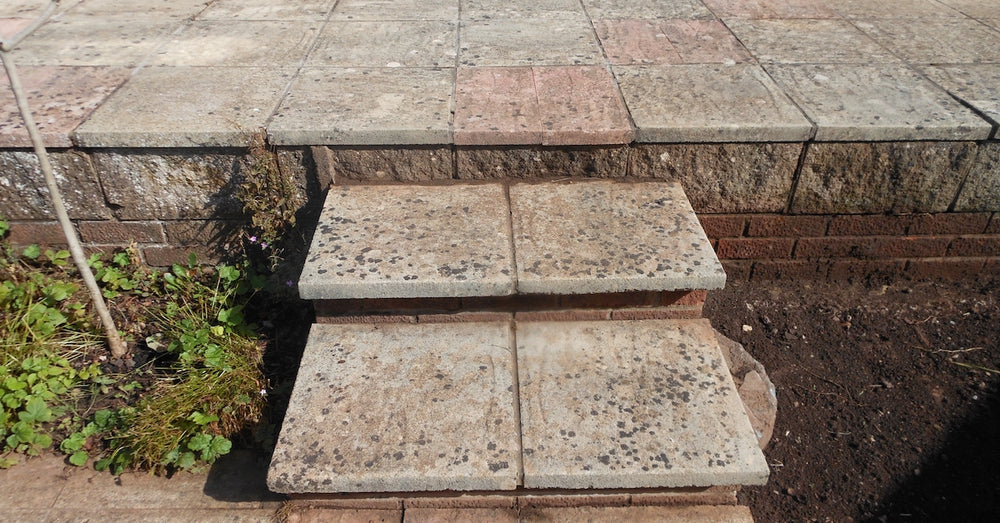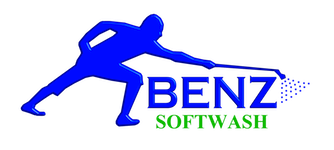
What's the most effective way to remove "black spot" (black algae & lichen) by soft washing?
Lichen are white, brown, yellow and black (i.e. "black spot") biological growths that live on slate and concrete tiled roofs, as well as on concrete paths, monoblock drives, brickwork, and occasionally on wall render.
Lichen can be very tough to remove and pressure washing alone is ineffective.
Watch the video below to get an overview of the best way to remove lichen (including "black spot") by soft washing
Lichen (including black lichen, or "black spot") attach themselves to, and grow into, the surfaces of roofs, paths and walls
The best way we've found to remove lichen is to first treat it with Benz Lightning Cleanze biocide to kill the growths and sanitise the surface; then follow up with Benz Tornado Cleanze, applied neat.
Follow this treatment by rinsing with a light pressure/jet wash, working the dead lichen with the jet to free them from the surface.
If some lichen staining remains, repeat the treatment.
Quick tip: Tornado Cleanze contains a particularly potent surfactant that can foam up when rinsing. To reduce foaming use low water pressure and minimise agitation.
Finally, give a biocide treatment with Benz Bio Cleanze. This will continue to deep clean over several months, killing any remaining spores, while also providing a degree of residual protection against recolonisation.
Important: If children or animals will walk on the treated surface, apply Bio Cleanze at only 50:1, keeping them well away from the working area and allow the surface to become completely dry before allowing them back.
Pressure (aka jet/power) washing and wall render
Important note re pressure washing: Using a pressure/power/jet washer on lichen without first killing it with a treatment of Benz Lightning Cleanze – which means the growths will still be well rooted into the surface – may damage the surface because the pressure will rip the still living roots out. Whereas after treatment the roots will be dead and will to a considerable extent have released their grip.
We've found that when first killed with a treatment of Lightning Cleanze biocide, jet washing will lift the roots out much more easily.
Important note re wall render: When treating render we do not recommend high-pressure jet washing, as it can damage the delicate surface of modern renders such as KRend and Weber.
Use of a jet washer, set to low pressure and/or using a wide angle fan jet, is fine for rinsing however. The pressure of the water when it contacts the render should be approximately that of tap water pressure.
The combination of Lightning Cleanze and Tornado Cleanze, followed by a light pressure wash will remove the majority of lichen, algae and black spot.
Bio Cleanze will then work through time – from 6 weeks to 12 months – to remove any remaining lichen and kill any remaining spores deep into the surface.
The actual time it takes Bio Cleanze to work depends on factors such as:
- The local environment
- Level of colonisation
- How long the colonisation has been allowed to grow into the surface
- Prevailing weather
- The exact type of biological growth ("black spot" can be caused by different biological species)
1) Treating lichen with Bio Cleanze only will also kill a lot of lichen (the exception being very heavy black lichen infestation such as seen in the photos, for which pre-treating with Lightning Cleanze followed by applying Tornado Cleanze we've found to be highly effective).
3) Many customers want to see immediate results, hence one of the reasons we suggest using Lightning Cleanze followed by Tornado Cleanze and, if necessary, a light jet/power wash for the first clean of paths and patios. Ongoing, regular 6-18 month treatments with Bio Cleanze will usually be sufficient to keep them permanently clean without further need for jet washing.
Time and the natural weathering of sun, wind and rain will usually lift the lichen from the surface once it is dead and it will disappear completely within a year
Enrol your customers into your ongoing "Clean & Maintain" softwash programme
The exact time interval varies according to multiple factors such as the material being treated, the local environment and weather conditions, plus how well your customer cares for and keeps their property clear of organic matter.
Patio slabs badly colonised by black lichen ("black spot") before soft washing:

The same patio slabs after black lichen ("black spot") has been removed by soft washing:

A path badly infested with black lichen ("black spot") and black algae in which the black lichen had grown deeply into the concrete slabs:

The same path after the black lichen / black spot and black algae has been removed by soft washing:
We've found the following sequence to be a highly effective way to remove black and white lichen:
1) Brush and hose down, or lightly pressure wash, the surface to remove loose organic matter.
2) Treat with Lightning Cleanze at 4:1 dilution, brushing the chemical into the lichen to help penetration (multiple treatments can be beneficial for badly affected surfaces).
3) Rinse and apply neat Benz Tornado Cleanze.
4) Lightly pressure wash any remaining black lichen, which will now be dead and its roots will more easily lift from the surface.
5) Apply Bio Cleanze at 50:1. This will find its way deep into the surface, clean out any remaining lichen spores, and provide long-term residual biocide protection against re-colonisation.
6) When the first signs of algae or lichen growth return, or as a 6-18 month regular maintenance treatment, it is usually sufficient to apply Bio Cleanze at 50:1 (40:1 in cold weather) alone as part of your ongoing maintenance plan.
Quick tip: Offering your customers a "Clean & Maintain" ongoing maintenance plan will give them a perpetually clean property and will give you a continual stream of repeat soft washing business.
Lichen usually takes a long time, even years, to return but sometimes, in damp, shaded areas of paths and patios, green algae will be noticed during the 6-18 months following treatment with Benz Softwash biocides.
At this point a quick "spray & go" with Bio Cleanze is all that is required to keep the surfaces immaculately clean and your customer very happy.
Click here to learn about our free online softwash training
Follow us online:
Instagram
Facebook
LinkedIn
Website
Click here to visit our softwashing how-to YouTube channel
Benz soft washing how-to videos cover every aspect of soft washing. We show you how to soft wash domestic and commercial roofs, paths and drives, tarmac, concrete, walls, wall render (including KRend, Monocouche, Weber), wet pour safety surfaces, tennis courts, car parks, wood decking, fences, sheds and more ...
Click here to get more practical soft washing how-to tips about using Benz Tornado Cleanze
How to find answers to most soft washing questions: Simply enter a relevant "keyword" or short phrase – e.g. keyword for the above link = "tornado" – into our in-site Search Engine (magnifying glass icon on the main menu).
You can order Benz Softwash chemicals & equipment online or by phone:
GB (England, Scotland, Wales)
Phone: 0800 70 74 222
Online: www.benzsoftwash.co.uk
Ireland and other countries
Phone: 00353 214 622 978
Online: www.benzsoftwash.com
Lines open Monday - Friday, 9am – 5pm
Please note: The above numbers are for orders only (click here for tech support)
We hope this information is helpful and sincerely wish you great success in your soft washing business,
Ben, Leo, Fiona, Stevie & Anthony
PS: After completing the first soft wash treatment, put your customer on a "Clean & Maintain" ongoing maintenance programme. Your customers will enjoy a permanently clean property and you will enjoy a steady stream of repeat business.
This is clearly a win-win arrangement for both customer and contractor.




Responses
Leo
Hey Keiron,
Thanks for letting us know. That’s not a use we’ve heard of before and great to add it to the list of uses Benz Lightning Cleanze can help with.
Cheers,
Leo
November 12, 2018
Keiron Bradley
Guys, thought you might be interested to know that I recently treated some tannin stains on render with Blackwash and it significantly reduced staining. It had leaked from wooden trellis on to newly rendered walls so after trying a small test patch I just sprayed it on, left for half an hour, rinsed and repeat.
Gave it several treatments without any agitation and stain was still faint but much better than it was, and the owner was well pleased.
November 12, 2018
Leo
Thanks Andrew!
June 24, 2017
andrew marling
Great informative videos.
June 21, 2017
Leave a comment